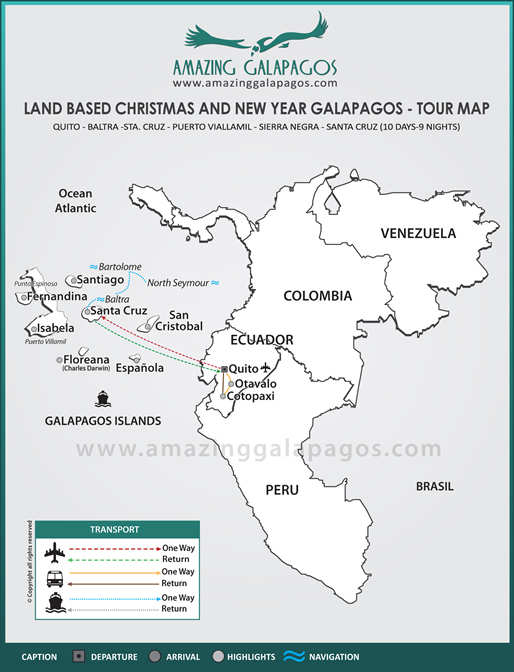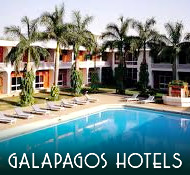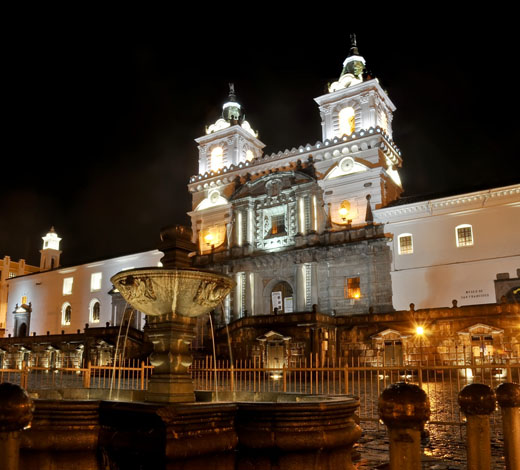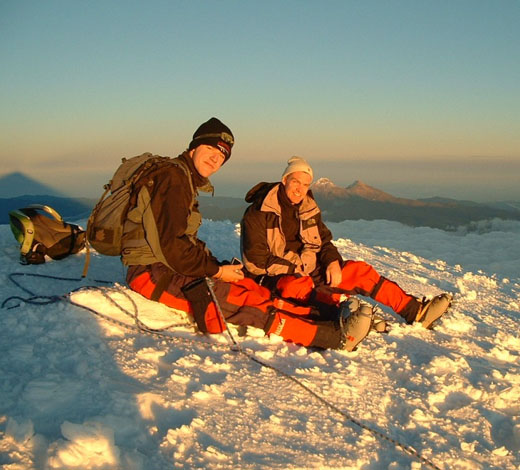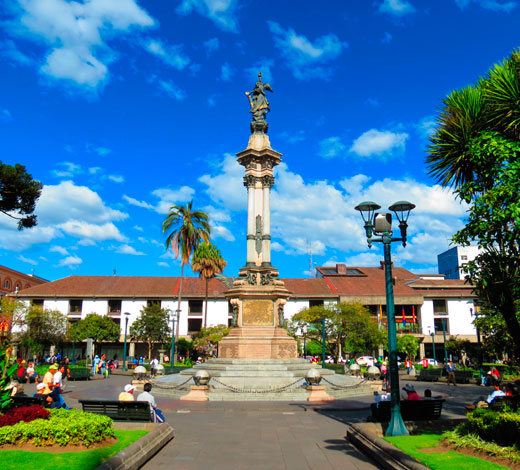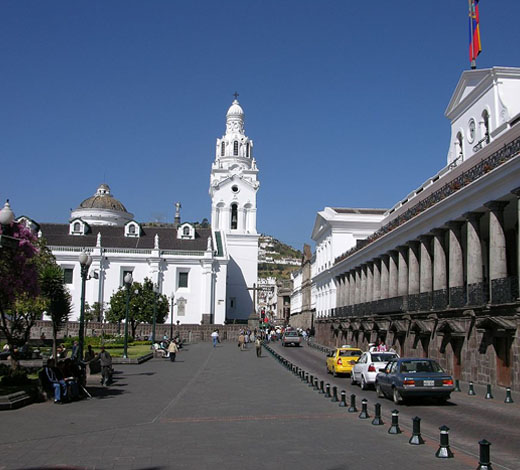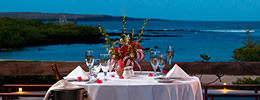Land based Christmas and New Year Galapagos 2026
Toll free in the USA & CANADA: 1 800-704-2915 - Worldwide
Arrival to Quito, reception and transfer to your hotel.
Day 2 (Dec. 24). Quito - OtavaloToday, after breakfast, transfer to Otavalo for a visit to the colourful Indian market of Otavalo, with its many impressive arts and crafts of the local people. The market dates back to pre-inca times when jungle products from the east were traded with highland products. Traditional dress is observed throughout the market. In the afternoon, a visit to Cotacachi, famous for its leatherwork. Return in the evening to Quito.
Day 3 (Dec. 25). Quito - CotopaxiAfter breakfast, we start our journey south through the spectacular avenue of the volcanoes towards Cotopaxi, the most famous of all Ecuatorian volcanoes. We shall pass Pasochoa, Ruminahui and Corazon volcanoes along this spectacular journey. Arrival to the magnificent Hacienda Cienega, one time residence of the German scientist Von Humboldt. After lunch at the hacienda, we shall visit the Hacienda San Agustin de Callo at the very foot of Cotopaxi. This Hacienda has been written about by the Spanish chronicler, Cieza de Leon (1553) and is one of only two major Inca sites in Ecuador. The temple was built around 1440 AD by one of the last Inca emperors, Huayna Cápac, and to this day the remaining rooms prevail as a magnificent sample of the unique style of Inca construction. The site is currently being investigated by Dr. David Brown of the University of Texas, the funding of which was provided by the National Geographic Society. Previously unknown portions of Inca walls and foundations have been discovered throughout the restoration process of the house. Since the 15th century San Agustin de Callo has served as an Inca fortress, Augustinian convent and temporary home for the French Geodesic Mission whose scientific results helped to determine the true shape of the planet. Continue the tour into the Cotopaxi National Park for a closer view of the volcano. Before returning to Quito, time permitting, we shall visit one of the Indian Markets, either Pujilí or Saquisilí. These are amongst the most authentic markets in Ecuador with their colourful displays of spices, fruits and hand woven ponchos. Return to Quito.
Day 4 (Dec. 26). QUITO - BALTRA - SANTA CRUZ BAfter breakfast transfer to the airport for your flight to Baltra, Galapagos. Reception and transfer to the Sol y Mar Hotel on Santa Cruz Island. Settle in to your hotel and relax in your sea view room. Take in the views, ambience and environment of the Galapagos with the sun, the sea, and salty-fresh island breeze. Visit the Charles Darwin station for an overview and history of the islands. Free day to explore the small town and enjoy the weather.
Day 5 (Dec. 27). SANTA CRUZ - TOUR OF THE ISLANDS B,L
After breakfast, enjoy a full day tour out to either Bartolome, North Seymour and Las Bachas, South Plazas or Punta Carrion. Each day the decision is made on which island is visited according to the permission by the government. This choice is made by evaluating where the other 100 yachts currently are stationed, and you will be able to visit the island with the least amount of tourist currently at land. Snorekeling opportunities are available on each island visit. Full day tour of the island, including lunch. In the late afternoon, return to the the Fernandina Hotel for a free evening.
Bartolome Island. Arriving at Bartholome we will ascend a lookout point from where you can admire the spectacular panorama of the Sullivan Bay and the famous needle shaped rock, the so-called Pinnacle Rock. The beaches at the foot of the Pinnacle Rock boast some fine snorkeling spots from which you can discover the marvelous underwater world with a good chance to encounter penguins or the softly gliding turtles. Bartolome is famous for Pinnacle Rock, a towering spearheaded obelisk that rises from the ocean's edge and is the best known landmark in the islands.
Galápagos penguins—the only species of penguin found north of the equator—walk precariously along narrow volcanic ledges at its base. Sea lions snooze on rocky platforms, ready to slide into the water to play with passing snorkelers. Just below the surface, shoals of tropical fish dodge in and out of the rocks past urchins, sea stars and anemones. A perfectly crescent, pink-and-white sandy beach lies just to the east of the pinnacle. Sea turtles use the beach as a nesting site and can sometimes be found wading in the shallow water near the shore, or resting in the sand to recover from the arduous task of digging nests, laying eggs and covering them over.
Penguins dot the nearby rocks of the next landing site, less than a kilometer along the eastern shore. Here the submerged walls of a tiny volcanic crater give the impression of a fountain pool. This dry landing—no wet feet!—is the entrance to a 600-meter (2000-foot) pathway complete with stairs and boardwalks leading to Bartolome's summit. The route is not difficult and presents a museum of vulcanology; a site left untouched after its last eruption, where cones stand in various stages of erosion and lava tubes form bobsled-like runs from the summit. At the top you will be rewarded with spectacular views of Santiago Island and James Bay to the west, and far below, Pinnacle Rock and our beach, where the crystal blue waters of the bay cradle your yacht.
North Seymour and Las Bachas. A visit to the island of North Seymour which is renowned for its frigate birds and their intensive courting rituals. The island is also inhabited by other frigate birds and blue-footed boobies, as well as endemic black lizards and sea lions inhabit on its shores. The deserted, picturesque beach Las Bachas at the northern shore of Santa Cruz invites you for a swim in the crystal-clear water or to relax in the sun. Afterwards you will be visiting the bay Caleta Tortuga Negra which is close by. This bay is surrounded by mangroves where you can spot pelicans and herons. While snorkelling you can have a swim with the turtles, white-tip sharks and rays.
North Seymour Island was lifted from the ocean floor by a seismic event, and its origins as a seabed give the island its low, flat profile. Cliffs only a few meters high form the shoreline, where swallow-tailed gulls sit perched in ledges. A tiny forest of silver-grey Palo Santo trees stand just above the landing, usually without leaves, waiting for the rain to bring them into bloom.
This island is teaming with life! You might have to give way to a passing sea lion or marine iguana; blue-footed booby nests sit beside the trail where mating pairs perform their courtship dance. Further along, the rocky shore displays white sand, and large flocks of pelicans mass for a dive-bomb feeding frenzy, rendering a tableau for us from ages long past. The trail turns inland to reveal the largest nesting site in the Galápagos of the "magnificent frigate bird." These huge, dark acrobats have two-meter wingspans, and males, with puffed up scarlet throat sacks, sit precariously perched in low bushes to watch over their equally large chicks.
Las Bachas, a sandy white-coral beach that is a major egg-laying site for sea turtles. Bachas are notches, and the beach's name refers to the indentations left in the sand by both laying turtles and their departing hatchlings. On the shore, there are marine iguanas and in the lagoon, flamingos are commonly seen. A newer visitor's site, Dragon Hill (Cerro Dragon) is a brackish water lagoon that attracts flamingos, common stilts, pintail ducks and other species of birds. There is a short walk up a small hill, which rewards hikers with a nesting site for iguanas and a great view!
South Plazas and Punta Carrion. Located In the east of Santa Cruz, the main characteristics of the small island of South Plaza are the Opuntia cacti and the carpets of red sesuvium, a succulent plant that turns green in the rainy season. The cactus is the main food of land iguanas, which are usually, found resting in the cacti's shade. The island contains one of the largest sea lion colonies of the Galapagos, along with swallow-tailed gulls and red-billed tropicbirds. Boobies are also found roosting on the southern cliffs of the island. Punta Carrion offers a great opportunity to see Sea Lions.
South Plazas: This is the southern partner of two small crescent-shaped islands that lie just a few hundred meters off the east coast of Santa Cruz. The northern island is used for scientific purposes only. South Plaza is one of the smallest yet richest islands in the archipelago. Only 130 meters wide (426 feet), it was formed from uplifted seabed, giving it a titled tabletop quality. Our landing is in the channel between North and South Plaza, where the island tilts toward the water.
The approach makes for a lavishly colorful sight! The turquoise waters of the channel contrast brilliantly with the white sand and black lava of the shoreline. The rocks have grown thick with green seaweed in places, speckled with bright orange “Sally light foot” crabs. Further up the shore a carpet of scarlet sesuvium succulents serves as groundcover for a grove of luminescent green prickly-pear cactus. Yellow-gray land iguanas sit beneath, waiting patiently for pears to drop.
The trail gradually follows the tilt of the island to the cliffs that overlook the ocean to the south, where swallow-tailed gulls nest. Red-billed tropic birds, masked and blue-footed boobies ride the windy currents. The overlook is a great place for spotting large marine life, including manta rays. Surf pounds an inlet at the western corner of the island, where a colony of sea lion bachelors make their home, accounting for the surface of the rocks, polished by the oils of their fur. The shoreline of Las Plazas makes for excellent snorkeling in a sea lion colony of nearly a thousand. Your guide will find the right spot to swim with youngsters away from areas claimed by the surly bulls.
After early breakfast, We drive up through the highlands of Santa Cruz to visit Los Gemelos (the twins).
Los Gemelos refers to the dramatic, twin volcanic sink holes, formed when surface magma chambers collapsed, causing the upper crust to sink, following circumferential fissures. These two pit craters more than 30m deep illustrate the volcanic origin of the islands. This whole area is cloaked in the humid tropical zone of the scalesia forest, giving it a pre-historical feel, typical of cloud forest vegetation. A few trails wander around the craters, and provide the perfect place for photography and walking, in addition to bird watching. Many land birds may be seen, such as the vermillion flycatcher, warblers, darwin finches, as well as bromeliads and orchids.
From here we continue to El Chato where we shall start our horse riding tour. The first part of the ride follows a track 5 km long and sometimes very muddy on to El Chato. This is a giant tortoise wild reserve, where you can see free-roaming giant tortoises placidly grazing in the lush vegetation, and often lying camouflaged, like half submerged boulders. The vegetation is composed of high scalesia, guayabillo (Psidium sp.) and pega pega (Pisonia floribunda) grasses.
As you ride through the forest, listen carefully for the sound of heavy foot steps and the sound of shrubs being slowly crushed, as this is the place where theses ancient reptiles make their way through the brush in search of water and plants to enjoy a meal. This will allow us to get close to and quietly observe these peaceful animals. A chance to enjoy this reserve before we make a visit to the lava tubes in the area which together with the tunnels of Northwest of Australia is amongst the largest in the world.
Return to Puerto Ayora and the Sol y Mar Hotel.
After breakfast, you will be met by your private transport to transfer up to the highlands where your mountain biking adventure begins. The bike routes up in the highlands are quite varied and so are their difficulty levels and landscapes. To begin the adventure, private transportation will take you to the highlands of Santa Cruz. The route that you will take will lead you to El Garrapatero. Most of the ride is downhill on moderate terrain (gravel and small rocks). Right behind the beach, there is an amazing brackish water pond where pin tail ducks, common stilts, and even flamingos can be observed. This beach is said to be one of the most beautiful in the Galapagos and you will have snorkelling equipment waiting for you there for your use as you explore the clear waters. Return to the Sol y mar Hotel.
Day 8 (Dec. 30). SANTA CRUZ - QUITO BAfter an early breakfast, transfer to the airport for your return flight to Quito. Reception and transfer to you hotel.
Day 9 (Dec. 31). QUITO B, L , DAfter breakfast, a full day's guided visit of colonial Quito, declared by UNESCO as a world heritage site in 1978. A visit to the Old Town, including the Plaza de la Independencia. The President still conducts business here, so access to the inside may be limited. It is the home of the tomb of Sucre and also houses interesting 17th and 18th century paintings. A visit to the Parque Alameda that houses the oldest astronomical observatory in South America, as well as an impressive monument of Simon Bolivar. The Plaza de San Francisco was constructed by the Spanish in 1553, and the church has a high altar made of gold and beautifully carved ceilings. You shall also visit La Compañia, the finest of all Jesuit churches. Damaged through the years by fires and earthquakes, it has since been restored and has a richly sculptured facade and interior. If time, we will visit the some of the markets, including the Indian market at Avenida de 24 de Mayo at the base of El Panecillo and the Ipiales market. These are best visited on Wednesdays and Saturdays, the main market days. Lunch at Café Mosaico; affording excellent views of Quito from its incredible location above Quito. Continue the tour to the middle of the world monument before returning to your hotel. Dinner and Gala at the Sheraton Four Points Hotel.
Day 10 (Jan 1). QUITO B
After breakfast, transfer to the airport for your return flight home.
End of services.
